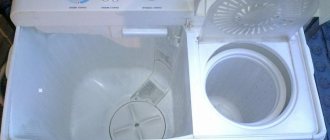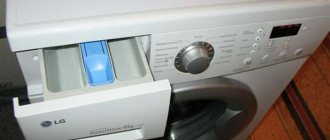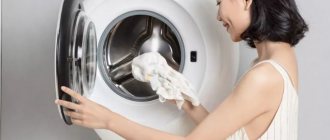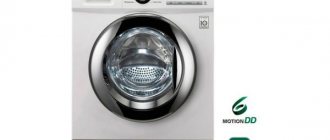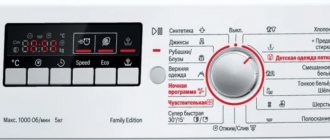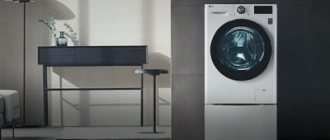Washing machines produced by Chaika are representatives of semi-automatic equipment in the budget series. This electrical equipment is designed for washing, rinsing and drying clothes at home. Depending on the model, it has different characteristics.
Washing machine produced by Chaika
Model overview
Chaika washing machines are a worthy example of a semi-automatic unit with a centrifuge that almost everyone can afford. Depending on the model, the characteristics of this type of equipment may vary.
"Seagull-3"
This is a high-quality washing machine with a centrifuge. It is characterized by a spin speed of 2800 rpm. The semi-automatic machine has 2 washing modes that can function together. The set of this model of household appliances includes a cover, drain and inlet hoses, a seal cover, tongs for things, and instructions for use.
"Chaika-2M"
This is a 2-tank semi-automatic washing machine. The unit includes a tank with a disk activator, a washing tank, a centrifuge and other elements. Ease of moving the machine is ensured by rollers and side handles.
Brief history of the model and its development
Production of the first model of the Chaika camera began back in 1965. Soviet amateur photographers at that time were already familiar with the Zenit, Zorkiy, Smena, Shkolnik, Agat and FED cameras and had the skills to use such equipment.
And we have mastered the theory of photography quite well. Therefore, there was increased interest in “The Seagull” from the very beginning.
A significant role in the popularity of the model was played by Valentina Tereshkova (the first woman in the world to be in space), after whom the new camera was named.
“Chaika” was its operational call sign when the rocket was launched into space in 1963.
The first model of the Soviet camera "Chaika"
Production continued from 1965 to 1974. During this time, 4 models “(Chaika”, “Chaika-2”, “Chaika-2M”, “Chaika-3”) and a pair of unique cameras were released, which were released in several copies (“Chaika-stereo” with two lenses and "Chaika-4" is a simplified version of "Chaika-3").
The total number of devices produced is about 2.2 million, not counting models aimed at the international market.
Expert recommendations
The washing machine will serve you well for many years if you follow simple rules for its use:
- Pour water to the required level.
- Do not pour too much powder, as during a quick wash the device will not have time to remove it. It is better to add it in the process if necessary.
- After washing, rinse and clean the inside of the tank, including an idle spin cycle with hot water.
- Wipe both tanks dry.
- Flush the pump and hoses.
- Store removable machine elements in a special niche.
The device must not be kept in a very cold or damp place. When operating the machine, power fluctuations must not be allowed - this can lead to burnout of the electronic filling of the device.
Chaika brand washing machines are very productive and indispensable for quick washing, but they require proper operation and due attention.
Method 1 - through the drain hose
The easiest and fastest way to remove water from a washing machine.
Procedure:
- disconnect the hose from the back wall of the unit and, if it is connected to the sewer, pull it out;
- position the hose below the tank level along its entire length;
- lower its end into the prepared container - the water should flow out on its own.
Article on the topic: Which vacuum cleaner is better, a washing one or one with an aqua filter?
In this way, you can remove almost all the water from the drum, however, this method is not applicable to all models of washing machines. For example, in some Bosch and Siemens models, the drain hose has a special loop inside the machine body, the main purpose of which is to prevent involuntary drainage of water during washing. Therefore, it will not be possible to remove water from the tank of such models through the drain hose.
You can find out whether your washing machine has such a design feature by referring to the instructions.
Popular models
Let's take a closer look at their characteristics.
"The Seagull 2m"
The design of the machine is quite simple: a body, two tanks (wash and spin), and three control knobs. Water is drained through a hole in the rear of the housing. The machine is equipped with recesses for comfortable carrying and wheels that facilitate movement on the floor.
seagull 2
The model includes two motors and a pump that pumps out water. The tanks are protected by a steel lid, on which you can place not too heavy objects. Two hoses are included: for drawing and draining water and tongs for rearranging laundry.
The process is controlled using three rotary knobs:
the first controls the wash;
the second starts the spin cycle and drains the water;
the third includes one of two modes.
The machine washes very quickly - from 2 to 5 minutes. Rinsing takes only 2 minutes, and spinning takes only 3 minutes.
Are you using citric acid?
Oh yes! No
Model "Seagull 3"
This machine has two washing modes that can work simultaneously, with a powerful centrifuge spinning at about 3000 revolutions. Thanks to this speed, things do not need to be dried additionally; they are removed from the tank almost dry.
The model is equipped with several important elements:
- lid;
- lid with seal;
- hoses for collecting and draining water;
- safety net;
- clothes tongs.
seagull 3
The machine comes with an instruction manual.
"Seagull 8"
The model is capable of washing in two modes; spinning is carried out in a centrifuge at a speed of 3000 revolutions. When you try to open the lid, the machine stops. Drainage is carried out by pumps through a hose.
Expert opinion
I work in the household appliance repair industry. Extensive experience in restoring washing machines and dishwashers.
Ask a Question
The water in the tank heats up to 90°C, and rapid rotation during spinning can be unsafe if you try to interfere with the work - you need to wait until the centrifuge stops completely.
You can turn on the washing or spinning mode by turning the knobs to the desired scale division corresponding to the minute. After the set time has elapsed, the device stops.
Do you wash your shoes in the machine?
Oh yes! No
Types of electric motors
An electric motor is a machine operating on electricity that moves various elements using a drive. They produce asynchronous and synchronous units .
Synchronous motor
It has been established since school days that when magnets approach each other, they attract or repel.
The first case appears at opposite magnetic poles, the second - at like ones. We are talking about stable magnets and the magnetic field they constantly organize. In addition to those presented, there are unstable magnets. Everyone, without exception, remembers the example from the textbook: the picture shows a magnet in the shape of an ordinary horseshoe. Between its poles there is a frame made in the shape of a horseshoe with half rings. Current was supplied to the frame.
Since the magnet rejects the same poles and attracts different ones, an electromagnetic field appears around this frame, which turns it in a vertical position. As a result, it is acted upon by a current opposite to the main case in terms of the symbol. The modified polarity rotates the frame and again sends it to the horizontal area. The operation of a synchronous electric motor is based on this belief.
In this circuit, current is supplied to the rotor winding , represented by a frame. The source that creates the electromagnetic field is the windings. The stator performs the functions of a magnet. In addition, it is made of windings or a set of stable magnets.
The rotor speed of such an electric motor is the same as the current supplied to the winding terminals, i.e. they work simultaneously, which gives the electric motor its name.
Asynchronous device
To understand the principle of operation, let’s remember the picture: a frame (but without half rings) is located between the magnetic poles.
The magnet is made in the shape of a horseshoe, the ends of which are united. We begin to slowly rotate it around the frame, observing what is happening. Until a certain point, the frame does not move. Further, at a specific angle of rotation of the magnet, it begins to spin behind it at a speed less than the speed of the latter. They do not work simultaneously, which is why the motors are called asynchronous.
In a real electric motor, a magnet is an electrical winding placed in the slots of the stator into which electric current is supplied. The rotor is considered a frame. In its grooves there are short-connected plates . That's what they call it - short-circuited .
Differences between electric motors
Externally, the motors are difficult to recognize. Their main difference is the operating rule. They also differ in their scope of application: synchronous, more complex in design, are used to drive equipment such as pumps, compressors, etc., i.e., operating at constant speed.
In asynchronous ones, as the overload increases, the rotation frequency decreases. They are supplied with a huge number of devices.
How to use “Chaika-2” correctly?
So, first collect your dirty laundry and put it in the right bin. Be sure to check all your laundry to ensure no extra items end up in the washing machine. In addition, some stains cannot be removed with one wash, so try to remove them in advance using special or traditional methods. If the laundry is very dirty or has traces of grass, then soak (for 20-35 minutes) the items in advance so that these “defects” are eliminated within one wash.
After this, select the appropriate mode and press the wash button. To dry washed laundry, place the items in the spinner tank. Depending on the volume of laundry, you can choose a quick or “full” wash.
A washing machine with a centrifuge performs washing without the loud sounds of a spinning drum. At the end of the washing process, you will hear a characteristic sound. Chaika-2 comes with instructions for quick and safe washing. This also eliminates the occurrence of breakdowns and repairs, respectively.
Connection diagram
Connecting a car's electric motor correctly is not so easy.
Need a wiring diagram for the motor from the washing machine. However, if you understand how this is done, it will not cause difficulties. First we need to find 2 pin pairs. To understand where they are, we can use a multimeter. Let's select one of the winding terminals and connect the tester probe. With the rest of the multimeter probe, we examine other terminals to find the paired one.
This way we will find the first pair. These 2 conclusions that have been preserved form another pair. Now we need to understand where the starting and working windings are. To do this, you need to measure the resistance. The starting part has more resistance.
So, we have already found a working winding. Now we can connect the motor using the drawing.
The diagram shows:
If there is a need to change the direction in which the motor will rotate, you will need to swap the software pins. With such a change, the direction of rotation will be reversed.
If you begin to make a trial connection and start the engine, do not forget to take care of your own safety and the safety of those around you, secure the electric motor. This will prevent strong vibrations and unnecessary movements.
Lubricating the Chaika sewing machine
Before you begin repairing and setting up the Chaika sewing machine with your own hands, it is advisable to do a routine inspection, cleaning, and lubrication. To do this, disconnect the electric motor from the mains and remove the top cover (it is secured with two screws from the top). Disconnect the presser foot, remove the needle and needle plate, and the hook mechanism cover. Remove the machine from the wooden stand or table. Disassemble the shuttle device: bobbin case, locking ring, shuttle. Now remove from the machine (especially in the shuttle compartment) dust, dirt, fuzz and lubricate all rubbing, accessible places well with machine oil. You can look at the places that need to be lubricated in the instructions for the machine or lubricate all accessible rubbing metal parts and assemblies.
For lubrication, it is very convenient to use a medical disposable syringe; just select a size so that it fits into the neck of the container with oil. The needle must be removed when “filling” with oil.
Connecting the engine to a 220 V network
If you need to connect the electric motor of a machine to a 220 volt network, then you need to take into account the characteristic features of this part. Its features are as follows:
To start, we need to connect the cable in the motor. We will not use the two white wires located on the left side. They are needed to measure the turns of the electric motor. The next one is the red wire. It passes to the stator winding. There is a brown wire behind it. It is also oriented towards one of the stator windings. The gray and green cables are connected to the motor brushes.
In order to show you the connection diagram more clearly, we have created the following diagram:
After this, you can connect the motor to the 220 network and check its functionality. If you did everything correctly, you will notice how the moving part of the engine rotates and hear the noise of its operation. If everything is fine, then the motor is ready for use. By the way, with this connection it moves in one direction.
What needs to be done to change the rotation? As you know from the schematic display, in order to change the direction of rotation, we needed to swap the connections of the electric motor brushes. After switching the motor, check its functionality again by connecting it to the network.
By the way, to make your work easier, we decided to add a video tutorial that describes the entire process of connecting the engine from the car to electricity.
The method of connecting an engine from a modern car in this article is based directly on the material used, which is shown in the video.
Model overview
"Chaika-2" became a representative of the improved version of "Chaika", which the Minsk Mechanical Plant named after S.I. Vavilov produced in much larger quantities. The model was produced from 1967 to 1972 and had a batch of 1,250,000 pieces. The Belarusian Optical-Mechanical Association enterprise not only changed the design of the body, but also optimized the internal technical capabilities of the camera. The removable lens had a threaded mount with a working length of 27.5 mm instead of the previously designed 28.8 mm. Considering the years of shortage of any equipment on store shelves, this equipment was a huge success and in demand.
At that time, the magazines “Soviet Photo” and “Model Designer” were published, where tables were published to help use “Chaika” cameras. The camera film with extension rings to obtain a reduced-size copy of the photograph contained 72 pages when shooting a book spread; reading was done using a children's filmoscope, which had a relatively low price. Reduction by microfilming varied within scales from 1: 3 to 1: 50. The technical characteristics of the model made it possible to focus on a distance scale. The optical viewfinder allowed telescopic magnification of 0.45. In order for the frame counter to reset, it was necessary to pull back the film rewind knob, which instantly unlocked the transport gear roller.
“Chaika-3” was the third variation of the camera of the same name, which was put into production in 1971. This is the first model in the Chaika line with a non-coupled selenium exposure meter. It is impossible not to note the changes in appearance along with certain improved technical characteristics of the device. Despite the relatively small batch of models produced, which did not exceed 600,000 pieces, this camera was able to combine modern design and increased ease of use. Now to insert and rewind the film, you need to turn the head located on the bottom panel.
Later, the fourth model “Chaika-2M” appeared, which did not have a photo exposure meter - a device that allows you to determine exposure parameters, including exposure time and aperture numbers. The device now has a clip for attaching a flash, which is necessary for photography in low light conditions. 351,000 copies of these cameras were produced.
Item Preview
>
Share or Embed This Item
EMBED
EMBED (for wordpress.com hosted blogs and archive.org item tags)
Want more?
Advanced embedding details, examples, and help
!
Flag this item for
- Graphic Violence
- Graphic Sexual Content
texts
Publication date 1992 Topics A300, PL Collection opensource; community language
technical certificate
Addeddate 2017-05-26 11:18:05 Identifier B-001-013-963 Identifier-ark ark:/13960/t25b5jd07 Ocr ABBYY FineReader 11.0 Pages 37 Scanner Internet Archive HTML5 Uploader 1.6.3 Year 1992
User manual
To prepare a semi-automatic washing machine for operation, you should open its lids and check the emptyness of the tanks. Next, the drain hose is connected to the outlet of the fitting, and the bent end is hung in a special place. After this, pour 1 liter of water into the washing tank. And test the operation of the equipment idle. Plug the power cord into the outlet, first checking that all relay handles are turned off.
Washing one load of laundry takes approximately 3-5 minutes. Rinsing can be done either in the washing tank or in a separate container.
Thoroughly rinsed items must be sent to the second spin tank. This procedure usually takes 3 minutes.
In order for the Chaika electrical circuit to serve for many years, you need to adhere to the following recommendations:
- always fill water to the indicated level;
- Do not pour a lot of washing powder at once, it is better to add it as needed;
- at the end of the washing procedure, you should wash the tank from the inside each time, and turn on the idle spin mode;
- Tanks must be wiped dry;
- do not forget about washing the hoses and pump;
- store removable parts from the machine in a special container.
Next, watch a video on how to operate the Chaika-3 washing machine.
Method 2 - through the drain filter
Almost all models of washing machines have a special filter that protects the drain pump from small objects entering it - coins, paper clips, etc. As a rule, access to this filter is located at the front at the bottom of the unit under a decorative hatch or panel. To drain water through the pump filter, proceed as follows.
Procedure:
- open the decorative sunroof or remove the panel (you may need to use a flat-head screwdriver to do this);
- tilt the washing machine slightly on its side and lean it against the wall so that you can slide a water container under the edge of the machine; be careful that the machine does not slip;
- grab the handle of the filter, turn it counterclockwise (do not unscrew it completely) and drain the water into the prepared container.
The main disadvantage of this method is that a large amount of water can spill onto the floor, and it will have to be removed manually with a rag.
Article on the topic: How to connect an automatic washing machine to a pumping station
Caring for household appliances
To extend the life of your household appliances, you should follow simple rules.
In particular, the instructions for the Chaika washing machine state that before washing you must:
- Fill the tank with hot water to the required level.
- Add washing powder.
- Turn on the engine of the Chaika washing machine for a few minutes.
Considering that the modes involve a quick washing scheme, it is necessary to use a small amount of detergent. At the end of the process, you should:
- Clean the inner mesh of the tank and rinse it.
- Rinse the hoses and pump with hot water.
- Wipe the centrifuge and wash tank dry.
- Place all components in a special niche.
Avoid storing equipment in rooms with high humidity or temperatures below +5C.
Machine diagram
Advantages of asynchronous motors
The electric motor that turns the drum is the heart of the washing machine.
The drive in the very first versions of the machines was belts that rotated the container with laundry. However, today the asynchronous apparatus, which converts electricity into mechanical energy, has been significantly improved. More often, washing machine circuits contain asynchronous motors, consisting of a stator, which does not move and serves as both a magnetic circuit and a supporting system, and a moving rotor that turns the drum. An asynchronous motor operates due to the interaction of the unstable magnetic fields of these structures. Asynchronous motors are divided into two-phase, which are less common, and three-phase.
Why is he so remarkable even now?
Recently, a whole layer of “film exotic” lovers has appeared. Modern digital SLRs are, of course, amazing inventions capable of producing the highest quality photos in high resolution, but the magic of the film camera has not disappeared.
Of course, no one talks about the daily use of Soviet film cameras, but the opportunity to get acquainted with the origins of photographic equipment excites the minds of even professional photographers, let alone beginners.
“Chaika” in modern realities is an excellent retro camera, capable of taking deep, atmospheric photographs. And today there are no problems with developing film, as well as with printing photos; there are companies on the Internet that provide similar services.
Repair of domestic washing machines
| Mains voltage, V | 220 | Dimensions, mm | 675x410x740 |
| Power consumption, W | 36 | Weight, kg | 44,8 |
Washing machine device.
The CHAYKA washing machine is designed for washing and rinsing clothes at home. The machine has a two-tank design and consists of a welded body, inside of which there is a washing tank and a centrifuge tank.
The activator drive consists of an asynchronous electric motor, pulleys and a V-belt. To reduce vibration and noise, the centrifuge has an elastic rubber suspension. A centrifugal pump is attached to one end of the electric motor shaft. It is connected by hoses to the valve device and the outlet fitting
Rice. 1
Appearance and structure of SM Chaika
On the housing cover there are two time relay handles for turning on the activator and the centrifuge. Four running rollers are attached to the machine body for ease of movement. To protect the electric motor windings, the RTK-S relay is included in the activator circuit, and the RT-10 relay is included in the centrifuge electric motor circuit.
Electrical equipment.
The electrical equipment of the Chaika washing machine consists of an M1 motor, type AVB-071-4S U4, 180 W, M191, TU 16-513-028-78; working capacitor SG type KBG-MN-2-600 V-6 μF ±10%, GOST 6118-78; thermal protective relay RT type RT-10-1.4-UHL4, TU 16-523-297-75; time relay RV type RV-6A, TU 25-07-1232-78; mode switch B2′ type S-1-00-4/250, TU 27-09-1222-78; electronic reversing device ERU type ERU-1-UHL4, TU 27-36-781-79 and radio interference filter elements - capacitors SZ'; C4′ type MBM-500 V-0.1 µF ±20%, GOST 23232-78 and resistor R type MLT-2-15 Ohm+10%, GOST 7113-77.
The centrifuge drive consists of an M2 motor type DCSM-ZB UHL4, 220 V, TU 16-513-368-78; working capacitor C2′ type MBGP-1-630 V-10 µF ±10%, GOST 7112-74; microswitch VG type MP 2101 U4, used. 311, TU 16-526-322-78 and time relay RV type RV-8A, TU 25-07-1232-78.
Rice. 2
Electrical circuit diagram of the Chaika washing machine.
When doing your own repairs, read the typical malfunctions of semi-automatic washing machines, as well as the interchangeability of parts and assembly units of washing machines of the SMP series.
The ERU installed on CHAIKA machines usually allows you to adjust the washing time from 0 to 6 minutes. For the best quality washing, the machine’s operating cycle should be as follows: 50 s – rotation in one direction, 10 s – break, 50 s – rotation in the other direction, 10 s – break, etc. In this case, the washing machine can be improved, see modernization of the washing machine, where a reverse device for the SM electric motor is proposed. This device is also suitable in case of ERU failure.
Used “Information materials of TsNIITEI. 1980-1990”
All the best, write
to Elremont 2005
Table of copper content in electric motor
In industrial production, electric motors play a vital role, as in many other areas of human activity. The operating principle of these devices is the conversion of electrical current into mechanical energy. It contains a large number of different materials, namely copper. Therefore, many users have a question about how much of this material is contained in electric motors.
Device parts containing copper
Copper is used to make many electric motor components, such as the commutator, winding wires and cables. That is why, when making them, you need to know the amount of copper that turns on the electric motor. Its quantity can be calculated by knowing the mass and power of the motor. You can accurately determine how much copper an electrical unit contains if you have data on its power and weight. At voltages of 220 and 380, the mass of this metal in the engine is different.
Winding wires
Winding wires are needed to repair and rewind electric motors. For this purpose, the metal is specially contaminated in order to reduce the inrush currents of the system. The windings have a round or rectangular cross-section, the type of which depends on the characteristics of the wire material, as well as on the type of insulation. As a rule, winding wires are made from copper parts with enamel or fiber insulation. The correct selection of these components is very important for the repair of an electrical unit. They are selected taking into account moisture resistance, frost resistance, susceptibility to heat, mechanical strength and chemical resistance. Winding wires are usually sold in drums, coils or spools. Each reel must have a label with the name of the manufacturer, brand, as well as size and weight. The last parameters are determined based on a special table.
Collector
When choosing a collector, it is also important to consider how much copper the electric motor contains. It is a hollow cylinder consisting of hard small plates. These plates are isolated from each other using micanite gaskets and cuffs.
Table of copper content in electric motors
If you are going to sell an electric motor for scrap, then you definitely need to calculate how many copper parts it contains. This mass can be found out from a special table, which takes into account the engine power, number of revolutions and its type.
| Types of electric motors | ||||||||
| power, kWt | 8/750 rpm | 6/1000 rpm | 4/1500 rpm | 2/3000 rpm | ||||
| 1 | 2 | 1 | 2 | 1 | 2 | 1 | 2 | |
| 0,06 | 0,419/0,485 | 3,3/3 | ||||||
| 0,09 | 0,542/0,534 | 3,3/3 | 0,426/0,440 | 3,3/30 | ||||
| 0,12 | 0,50/0,48 | 4,5/4,3 | 0,542/0,534 | 3,3/30 | ||||
| 0,18 | 0,64/0,62 | 6,3/6,1 | 0,55/0,63 | 4,5/4,3 | 0,42/0,38 | 4,5/4,30 | ||
| 0,25 | 0,95 | 15,1/14,0 | 0,83/0,85 | 6,3/6,1 | 0,59/0,61 | 6,3/6,1 | 0,45/0,44 | 4,5/4,30 |
| 0,37 | 1,16 | 17,5/17,1 | 0,97 | 15,1/14 | 0,59/0,61 | 6,3/6,1 | 0,58/0,55 | 6,3/6,10 |
| 0,55 | 1,33/1,34 | 20,0/19,5 | 1,08/1,11 | 15,1/14 | 0,92/0,93 | 15,1/14 | 0,60/0,62 | 6,3/6,10 |
| 0,75 | 1,58/1,62 | 25,5 | 1,24/1,19 | 17,5/17,1 | 0,94/0,97 | 15,1/14 | 0,91/0,93 | 15,10/14 |
| 0,9 | 1,59/1,53 | 25,5 | ||||||
| 1,1 | 1,91/1,92 | 25,5 | 1,58/1,51 | 20,0/19,5 | 1,36/1,35 | 17,5/17,1 | 0,96/0,92 | 15,10/14 |
| 1,2 | 1,91/1,87 | 25,5 | ||||||
| 1,5 | 2,28/2,25 | 42,0/40,5 | 1,95/1,92 | 28,7/25,5 | 1,49/1,44 | 20,0/19,5 | 1,59/1,51 | 17,50/17,10 |
| 1,7 | 2,56/2,49 | 42,0/40,5 | 1,88/1,90 | 28,7/25,5 | ||||
| 2,2 | 3,04/3,16 | 56,0/54,0 | 2,28/2,25 | 42,0/40,5 | 1,92/1,87 | 28,7/25,5 | 1,82/1,74 | 20,0/19,50 |
| 2,4 | 1,92/1,93 | 28,7/25,5 | ||||||
| 3 | 3,45/3,65 | 56,0/54,0 | 3,05/2,99 | 56,0/54,0 | 2,80/2,95 | 36,0/36,4 | 2,51/2,6 | 28,7/25,5 |
| 3,5 | 2,50/2,42 | 28,7/25,5 | ||||||
| 4 | 77,0/72,0 | 3,42/3,42 | 56,0/54,0 | 2,81/2,95 | 42,0/40,5 | 3,76/3,64 | 36,0/36,4 | |
| 5,5 | 93,0/90,0 | 4,35/4,38 | 77,0/72,0 | 3,49/3,53 | 56,0/54,0 | 4,12/4,0 | 42,0/40,5 | |
| 7,5 | 7,32 | 135,0 | 4,94/5,07 | 93,0/90,0 | 5,44/5,20 | 77,0/72,0 | 4,79/4,71 | 56,0/54,0 |
| 11 | 8,41/8,52 | 160,0 | 7,90/8,12 | 135,0 | 6,09/6,26 | 93,0/90,0 | 93,0/90,0 | |
| 15 | 11,7/11,6 | 195,0 | 9,21/9,31 | 160,0 | 9,9/10,9 | 135,0 | 9,0/9,2 | 130,0 |
| 18,5 | 13,5/13,1 | 270,0 | 12,1/12,2 | 195,0 | 11,3/11,2 | 160,0 | 9,7/9,6 | 145,0 |
| 22 | 14,53 | 310/300 | 15,9/15,8 | 270,0 | 13,20 | 175,0 | 12,5/12,3 | 165,0 |
| 30 | 19,4/19,3 | 355,0 | 16,8/16,6 | 310/300 | 14,5/14,4 | 195,0 | 14,8/14,4 | 185,0 |
| 37 | 22,7/23,5 | 490,0 | 21,3/21,6 | 355,0 | 17,6/18,1 | 270,0 | 19,7/19,5 | 255/250 |
| 45 | 26,8/25,8 | 535,0 | 26,61 | 490,0 | 20,5/19,5 | 310/300 | 21,0/20,7 | 280/275 |
| 55 | 785,0 | 27,0/27,9 | 535,0 | 25,8/25,1 | 355,0 | 24,8/24,7 | 355/350 | |
| 75 | 835,0 | 785,0 | 39,6/38 | 490,0 | 33,0 | 470,0 | ||
| 90 | 875,0 | 835,0 | 43,8/40,0 | 535,0 | 34,8/35,0 | 510,0 | ||
User manual
To prepare a semi-automatic washing machine for operation, you should open its lids and check the emptyness of the tanks. Next, the drain hose is connected to the outlet of the fitting, and the bent end is hung in a special place. After this, pour 1 liter of water into the washing tank. And test the operation of the equipment idle. Plug the power cord into the outlet, first checking that all relay handles are turned off.
Washing one load of laundry takes approximately 3-5 minutes. Rinsing can be done either in the washing tank or in a separate container.
Thoroughly rinsed items must be sent to the second spin tank. This procedure usually takes 3 minutes.
In order for the Chaika electrical circuit to serve for many years, you need to adhere to the following recommendations:
- always fill water to the indicated level;
- Do not pour a lot of washing powder at once, it is better to add it as needed;
- at the end of the washing procedure, you should wash the tank from the inside each time, and turn on the idle spin mode;
- Tanks must be wiped dry;
- do not forget about washing the hoses and pump;
- store removable parts from the machine in a special container.
Next, watch a video on how to operate the Chaika-3 washing machine.
Method 4 - directly by opening the hatch
If the previous methods did not help you drain the water from a broken washing machine, you can try to “solve the problem head-on” - open the door and empty the water from the drum manually.
Procedure:
- if the water level in the machine is higher than the bottom edge of the hatch, tilt the washing machine back and carefully lean it against the wall so that when you open the door, water does not spill onto the floor;
- open the washing machine door;
- Scoop out the water using a ladle, mug or jar.
Of course, this method is not very convenient: it takes a long time, does not allow you to completely remove all the water, and, moreover, the machine door can be locked even after disconnecting from the power supply.
Peculiarities
The “Chaika” camera received its name in honor of the great female cosmonaut V. Tereshkova and was invented in 1962. The first model had a half-format camera, namely 72 frames in the 18x24 mm format. The camera body was made of metal and was equipped with a hinged lid. The rigidly built-in Industar-69 lens had focusing with a lens field of view angle of 56 degrees.
The device automatically read the number of photographic frames taken, and also provided the user with the opportunity to reset and reset the ongoing numbering. It should be noted that there is not only focusing on a certain scale, but also an optical viewfinder. The first batch of Chaika cameras amounted to 171,400 pieces. The model was produced until 1967, when the manufacturer presented customers with an updated version of the camera with the same name “Chaika-2”.
Possible causes of failure
Chaika 85 is an older model, so it is more susceptible to possible breakdowns, but this does not mean the quality of the equipment is poor. All models are complex mechanisms, and, as you know, any mechanism is susceptible to breakdown.
The most common reasons why a washing machine breaks down due to reasons beyond the user’s control are:
- hard water provokes the appearance of scale on the internal parts of the unit, which leads to their rapid wear;
- Voltage fluctuations can cause burnout.
You should also carefully follow the washing instructions to avoid damage and the need for repairs. Exceeding the possible load of laundry can also cause malfunction of the machine.
Draining
Method 5 - through the drain pipe
The last resort option that should be resorted to if all four of the above methods did not bring results or it was not possible to use them (for example, your machine does not have an emergency drain hose) is to force the water to drain through the drain pipe.
Note! As a rule, if water does not drain out when you unscrew the drain filter, this means that there is a blockage in the drain pipe. Therefore, this method, in most cases, will help not only drain the water from the washing machine, but also eliminate the reason why the washing machine stopped running with water.
- remove the back wall of the washing machine and identify the drain pipe, it is located under the drum;
- if possible, place a flat container under the pipe and place dry rags - a flood is imminent;
- remove the clamp that connects the pipe to the pump and disconnect the pipe; water should flow out of it;
- if there is no water, it means there is a blockage in the pipe; Carefully insert your fingers inside the pipe and remove the blockage.
Article on the topic: Where are Siemens washing machines assembled?
This method is certainly difficult to implement - it will be problematic for the “blonde” to cope with it, but it allows you to completely drain the water from the drum.
Lubricating the Chaika sewing machine
Before you begin repairing and setting up the Chaika sewing machine with your own hands, it is advisable to do a routine inspection, cleaning, and lubrication. To do this, disconnect the electric motor from the mains and remove the top cover (it is secured with two screws from the top). Disconnect the presser foot, remove the needle and needle plate, and the hook mechanism cover. Remove the machine from the wooden stand or table. Disassemble the shuttle device: bobbin case, locking ring, shuttle. Now remove from the machine (especially in the shuttle compartment) dust, dirt, fuzz and lubricate all rubbing, accessible places well with machine oil. You can look at the places that need to be lubricated in the instructions for the machine or lubricate all accessible rubbing metal parts and assemblies.
For lubrication, it is very convenient to use a medical disposable syringe; just select a size so that it fits into the neck of the container with oil. The needle must be removed when “filling” with oil.
Adjusting the vertical position of the needle
The transverse position of the needle is regulated by a rod mounted on a plate with two screws and a plate pressing the needle bar frame to the bracket rod. Adjusting this unit is quite complicated and requires experience, but, unfortunately, it is this mechanism that can spontaneously go astray during operation, especially with the Chaika electric sewing machine. Therefore, if you decide to repair your sewing machine yourself, you should learn how to adjust the position of the needle, since moving the needle forward is the cause of its breakdown, and moving it away from the seamstress is the cause of skipping.
Adjusting the needle position requires professional knowledge and experience. If you are not sure that you can do it yourself, contact a specialist, since it may cause failure of other components, the repair of which cannot be learned from a boring book stuffed with technical terms and diagrams.
It can be added that when using a crooked needle, notches may form on the nose of the shuttle, which “fluff” the thread and break it. The nose of the shuttle should be perfectly smooth and sharp, without roughness. Its condition can be determined by running your fingernail along the edge of the nose or using a magnifying glass. The clamping plate tightening screw should not be jagged, the latch handle should be clearly fixed and its surface should be clean and smooth. The shuttle itself must also be perfectly clean, without nicks or rust stains.
Speed controller
The motor from the washing machine has quite high speeds, for this reason it is necessary to make a regulator so that it works at different speeds and does not overheat.
A regular light intensity relay will do for this, but a little modification is required. We remove a triac with a radiator from the previous car. This is the name of an electronically controlled semiconductor device that performs the function of a switch.
Now it is necessary to solder it into the relay circuit to replace the low-power part. If you do not have such skills, it is preferable to entrust this operation to a specialist - a familiar electronics engineer or computer engineer.
In some cases, the engine copes normally without a speed controller.
Setup and adjustment
Setting up any Seagull sewing machine should start with adjusting the accuracy of the shuttle device. The joint actions of the shuttle and the needle are observed. The thread tension is adjusted. This affects stitches and lines.
Setup instructions
Setting the shuttle position
Broken threads and lines are the result of incorrect adjustment of the shuttle position. When a needle encounter occurs, gaps occur. Gaps should be avoided. To work, inspect the machine and find the shuttle fastening. The fastening mechanisms are unscrewed. The shuttle mechanism is moved. The shuttle stroke is advanced according to the position of the needle.
You may be interested in this Step-by-step guide to sewing a cover with an elastic band for a stool
Important! There are no extra parts after assembly. Shuttle machine
Shuttle machine
Interaction between shuttle and needle
The needle and shuttle must be correctly positioned in relation to each other so that the work is made of even and beautiful lines. Maintain a distance of 0.1 mm. When the needle exits from bottom to top - 2.0 mm. The spout under normal conditions fits 2 mm above the eyelet.
Visual position
Tips for working
When using a powerful machine motor in a new guise, you must remember 2 important nuances of connecting it:
Before connecting, we recommend that you understand the wires of different colors located there on the transfer case:
Be prepared for the fact that in different modifications the wires differ in color, but the principle of their connection remains constant. To identify pairs, ring the wires in order: those going to the tachogenerator have a resistance of 60-70 Ohms. Move them aside and secure them together with electrical tape so that they do not interfere. Ring the other wires to find a pair for them.
Characteristic
The Chaika washing machine began to be produced back in the days of the Soviet Union. This type of technology quickly became popular among the population, as it freed housewives from hand washing. They are still used today; sometimes such units are found in country houses or rented apartments. This is not surprising, since the service life of this washing machine is about 20 years.
"Chaika" consists of two tanks:
- the first one washes clothes;
- the second is wrung out followed by drying.
During the working process, soiled items are placed in the first tank, and after washing is completed, they are moved to the second, where they are wrung out.
Reasons to call a washing machine repair technician
If problems arise in the operation of the Chaika 2m washing machine, or other models, you should call a technician to fix the problem.
Reasons for concern may include:
- presence of a burning smell;
- During operation, the device makes a grinding noise, excessively rumbles or vibrates;
- the washing process significantly exceeds the set time;
- The elements for selecting washing modes do not work;
- water does not heat up or flows out;
- The machine does not drain the liquid.
Having certain skills in working with electrical circuits and a set of necessary tools, you can independently repair the washing machine. However, if there are no basic techniques for working with mechanical and electrical circuits, a qualified specialist should be involved in the repair.
Method 3 - through the emergency drain hose
Some models of washing machines are equipped with a special tube for emergency water drainage. It is located next to the drain pump filter under a decorative hatch or panel on the front of the machine. To drain the water, pull out the tube, remove the cap from it and drain the water into the prepared container. The main disadvantage is that due to the small diameter of the tube, draining can take quite a long time. In addition, not all car models have such an “option”.

